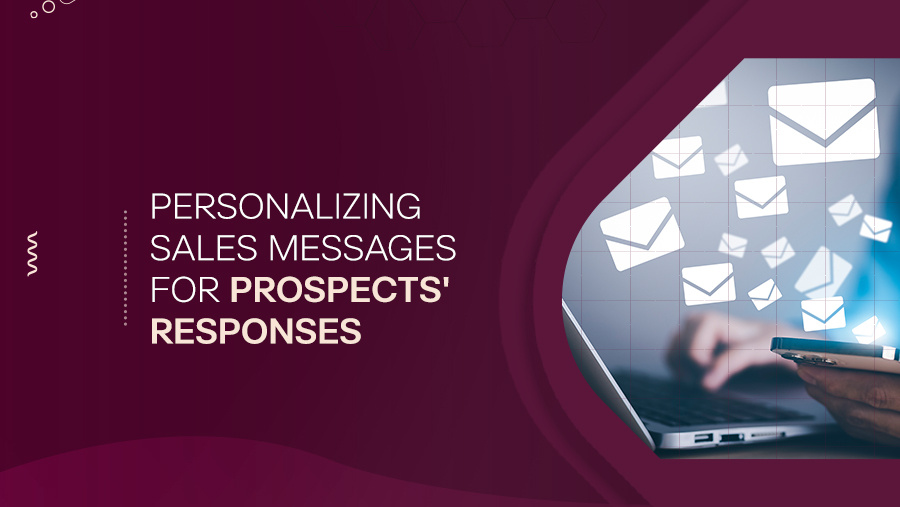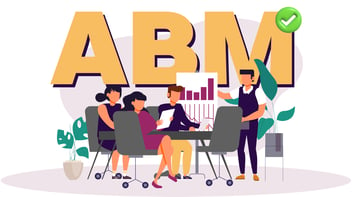
Personalization Playbook for Crafting Outbound Sales Messages That Get Responses
Imagine sending out a hundred identical messages, hoping someone will respond. Now, picture tailoring each letter to its recipient's interests and needs. Which approach do you think yields better results?
Personalization isn't just a nice extra in outbound sales—it's absolutely essential. Statistics show personalized messages can improve revenue by up to 40% compared to their generic counterparts.
This stark contrast highlights the power of understanding and addressing your prospects' concerns and desires. As we delve deeper, let's explore why and how personalizing your outreach can significantly elevate your sales outcomes.
Tactics to Set the Stage for Personalization in Outbound Sales
It is critical to cut through the noise and connect with your prospects on a level that resonates with them. Here's a detailed guide on leveraging personalization tactics to enhance your outbound sales strategy:
1. Analyze Your Target Prospects
You must precisely understand your target audience to lead an effective marketing strategy. Here's how you can deeply analyze your target prospects:
- Market Research: Take a systematic approach to market research. Ensure every step is purposeful and builds toward optimizing your outbound sales initiatives.
Here is a sample outline for your market research process tailored explicitly for outbound sales efforts:
.jpg?width=1400&height=2420&name=Personalization%20Playbook%20Table%201%20(2).jpg)
- Listen To Your Sales Calls : Analyze your prospects/customers' conversational insights during the sales calls. Doing so is an amazing method to identify your prospects’ language. You can learn how they utter their pain points. Thus, in place of using random words, you will lthe phrases, languages your target prospects are familiar with.
- Competitive Analysis: Look at your competitors' customer base to identify any gaps in their strategies that you can fill.
You can see that thorough market research gathers detailed customer insights. Thus, it enables you to develop ICP and buyer personas. These tools distill critical demographic, psychographic, and behavioral traits. They guide you to tailor your marketing strategies and product development to meet your most likely buyers' precise needs and preferences.
2. Segment Your Audience
Once you complete your market research and create your buyer persona and ideal customer profile (ICP), segment your audience. It allows you to tailor your messaging more effectively. Here are some techniques:
- Demographic Segmentation: Split your audience by age, location, job role, etc.
- Behavioral Segmentation: Categorize based on user behavior like purchase history, website engagement, etc.
- Needs-based Segmentation: Group prospects based on specific needs or problems they have expressed.
3. Craft Your Message
Structure, writing style, and tone of your messaging are essential to personalization. So, to ensure you do it right, follow these tips:
-
Start with a Strong Opening
Capture your prospect's attention with a compelling opening line that speaks directly to their needs or interests.
Example: "Struggling with high employee turnover? Our unique HR solutions can help."
-
Customize Content
Align your message with the recipient's needs, interests, and pain points. Use these tips:
- Use the information from your CRM to reference previous purchases or interactions.
- Highlight how your product/service solves a specific problem they have.
-
Use the Right Tone and Language
Choose a messaging style and speech that matches your audience's professional level yet feels personalized and direct.
Next up,
Check out how we perform critical messaging development for our clients at Revnew:
We skillfully craft compelling messages leveraging frameworks such as ICP and Jobs To Be Done (JTBD), ensuring your messaging profoundly resonates with your target customers.

4. Use Technology to Enhance Personalization
Technology can be your best bet when refining personalization in your outbound messaging. Here's how different tools can help you:
-
Artificial Intelligence (AI) and Machine Learning (ML)
These technologies analyze large volumes of data to identify patterns and predict prospect behaviors. You can leverage the following solutions of these techs to enhance your outbound personalized messaging:
- Behavioral Prediction: AI algorithms can predict how customers are likely to behave in the future based on their past actions. It can include predicting:
- What products might they buy next
- When they are likely to make a purchase
- How they prefer to be contacted
- Dynamic Personalization: With ML, you can dynamically tailor messages in real time.
Suppose AI detects a prospect looking at a specific product or solution. Then, it can customize the outbound message to highlight features or offers related to that product.
- Sentiment Analysis: AI tools can analyze the tone and sentiment of previous customer interactions. Thus, it allows you to adjust the tone of your messages to better align with customer emotions and increase engagement.
-
Automation Tools
You need these tools to manage large-scale cold email campaigns. They ensure consistent contact with your prospects. Let us see how they work for you:
- Get Automated Workflows: The tools let you set up automated email sequences triggered by specific customer actions.
For example, if a customer downloads a white paper, they automatically receive a follow-up email tailored to the content they showed interest in.
- Highlight Personalized Tags: These tools allow the inclusion of custom tags in emails. They include the recipient's name, company name, or details about their last interaction. Such a personal touch can make communications more one-to-one, even though they are automated.
-
Analytics and Feedback Loops
You must not just talk but also listen intently to what your audience prefers and reacts to. Monitor critical metrics to understand what strikes a chord with your prospects.
For example, let’s say data shows that a particular group of customers consistently engages with emails, including video tutorials. Armed with this insight, you would tailor upcoming communications to feature more such content. This way, you can enrich the brand experience for this segment.
Feedback loops take this a step further by integrating customer reactions directly into the strategy.
- If a customer responds positively to a specific message, it signals a green light to continue in that vein.
- Conversely, if the feedback is less enthusiastic, it's a prompt to pivot and try a new approach.
This dynamic adjustment helps keep the content fresh and relevant.
It's a powerful cycle: analyze, adapt, and improve. By continually refining communication strategies, you can ensure your messages reach your audience and resonate deeply.
However, irrelevant and intrusive personalization can backfire on your efforts. Thus, you must be aware of best practices to adopt.
Best Practices for Personalized Outbound Sales Messages
Let's dive into how to sharpen your messages to connect with your prospects effectively.r prospects.
1. Run A/B Testing
Create two versions of a brand message—Version A might have a more direct call to action, while Version B could be more narrative. Send these two variants to a segment of your audience and observe which one performs better in terms of:
- Open rates
- Click-throughs
- Conversions
-you learn what resonates best with your audience.
Over time, this method allows you to hone in on the most effective messaging elements. Thus, it optimizes your overall strategy. It's like testing which key opens a lock faster than using that key every time!
2. Pay Attention to Ethical Considerations
When it comes to personalized messaging, walking the ethical line is crucial. You want to make sure you're respecting privacy and adhering to regulations. Key policies to keep in mind include:
- GDPR (General Data Protection Regulation): Requires consent before gathering data from individuals in the EU.
- CAN-SPAM Act: Mandates a precise mechanism for opting out of emails in the U.S.
- CCPA (California Consumer Privacy Act): Gives California residents the right to know what personal data is being collected and to refuse the sale of their personal information.
These laws ensure that while personalizing content, you respect consumer rights and maintain trust—essential in today's market.
3. Pick the Right Frequency and Timing
Timing and frequency are all about hitting that sweet spot—when your message is most likely to be seen and acted upon without annoying the recipient.
Here's a breakdown of the best times to send outbound messages through various channels:
Cold Email:
- Day: Tuesdays tend to have the highest open rates, according to HubSpot.
- Time: Aim for 9 AM and 12:00 PM in your recipient's time zone. Avoid weekends and evenings when people are less likely to check work email.
Cold Call:
- Day: Tuesdays, Wednesdays, and Thursdays are generally considered the best days for cold calls. The reason is Mondays and Fridays are often filled with meetings or catch-up tasks.
- Time: Lunch breaks (around noon) can be surprisingly effective, as people might be more receptive to a short conversation. Mornings (between 10 AM and noon) are also a good option. Avoid early mornings or late afternoons when people are typically busy.
LinkedIn Outreach:
- Day: Wednesdays, Tuesdays, and Thursdays tend to have the highest engagement rates on LinkedIn.
However, some studies suggest weekdays might be better than weekends.
- Time: Similar to emails, mornings (between 8 AM and noon) might be a good option as people log in and check their notifications.
Frequency
It's essential to strike a balance between persistence and being a nuisance. Generally, for both emails and LinkedIn messages, it's safe to send a follow-up message after 3-5 business days if you haven't received a response.
For cold calls, you can try again once a week for a maximum of 2-3 attempts. However, it largely depends on your sales cycle.
4. Pick Key Metrics to Monitor
To gauge the effectiveness of your personalized messages, there are a few metrics you should keep an eye on:
- Open rates: How many people are opening your emails? It gives you an indication of how compelling your subject lines are.
- Click-through rates (CTR): How many people open the emails and click on the links provided? This measures interest and engagement with the content.
- Conversion rates: How many clicks convert into the desired action, such as filling out a form or purchasing?
- Unsubscribe rates: How many people are opting out after receiving your message? This can help you adjust the tone and frequency.
Monitoring these metrics helps you understand what's working, what's not, and where there's room for improvement. Think of it as keeping a pulse on the effectiveness of your communication strategy.
By following these best practices, you can craft outbound sales messages that are personalized, timely, respectful, and significantly effective in driving results.
Conclusion
Remember that crafting personalized outbound sales messages is about striking the right chord at the right time. Embrace the best practices to leverage these messages. This way, you can set the stage for enhanced engagement and better conversion rates. Dive into personalization, and watch your connections with prospects deepen and your results soar.
Let Revnew guide you on this journey. We can help you personalize your outbound sales messages to be practical and ethically sound. Contact us here to learn more about our services.




